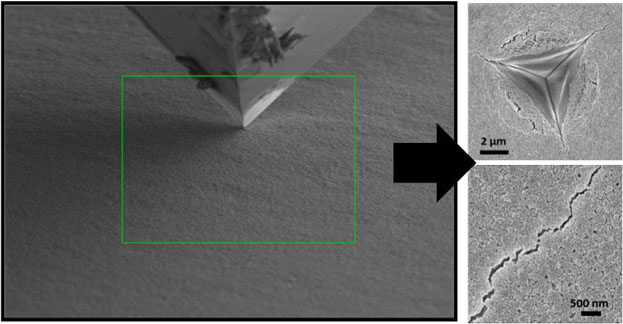Nanoindentation: Probing Mechanical Properties at the Nanoscale
What is Nanoindentation?
Nanoindentation is a powerful technique used to measure the mechanical properties of materials at the nanoscale. It involves pressing a hard tip, typically made of diamond, into the surface of a sample with a precisely controlled force and measuring the resulting indentation depth. By analyzing the force-displacement data, researchers can extract valuable information about the material's hardness, elastic modulus, and other mechanical characteristics.

In situ SEM nanoindentation of a nacre-like nanocoating on glass, showcasing crack deflection and material strain hardening capabilities. (Image: F. De Luca)
Instrumentation and Technique
Nanoindentation experiments are performed using specialized instruments called nanoindenters. These instruments typically consist of a rigid frame, a precise actuator for applying the load, and a sensitive displacement sensor for measuring the indentation depth. The indenter tip, usually made of diamond, can have various geometries, such as Berkovich (three-sided pyramid), Vickers (four-sided pyramid), or spherical.
During a nanoindentation test, the indenter tip is brought into contact with the sample surface, and the load is gradually increased to a predetermined maximum value. The load is then held constant for a set duration to allow for any time-dependent deformation (creep) to occur. Finally, the load is gradually reduced, and the tip is withdrawn from the surface. Throughout the test, the applied load and the corresponding displacement of the indenter tip are continuously recorded.
Data Analysis and Properties
The force-displacement data obtained from a nanoindentation test is analyzed using established models, such as the Oliver-Pharr method, to determine the mechanical properties of the material. The two primary properties derived from nanoindentation are hardness and elastic modulus.
Hardness is a measure of a material's resistance to plastic deformation and is calculated as the maximum load divided by the projected contact area of the indentation. The elastic modulus, or Young's modulus, quantifies the material's stiffness and is determined from the initial slope of the unloading portion of the force-displacement curve.
In addition to hardness and elastic modulus, nanoindentation can provide insights into other mechanical properties, such as fracture toughness, strain-hardening behavior, and time-dependent deformation (creep or viscoelasticity). Advanced nanoindentation techniques, such as continuous stiffness measurement (CSM) and dynamic nanoindentation, enable the measurement of properties as a function of indentation depth or frequency.
Applications of Nanoindentation
Nanoindentation finds widespread applications in materials science, nanotechnology, and various industrial sectors. Some key applications include:
- Characterizing the mechanical properties of thin films, coatings, and nanostructured materials
- Studying the local mechanical behavior of multiphase materials, such as composites and alloys
- Investigating the effects of microstructure, grain size, and defects on mechanical properties
- Evaluating the performance and durability of materials for applications in microelectronics, aerospace, and biomedical devices
- Probing the mechanical properties of biological materials, such as bones, teeth, and soft tissues
Challenges and Future Directions
While nanoindentation has become a well-established technique, there are still challenges and opportunities for further development. One challenge is the accurate determination of the projected contact area, particularly for materials that exhibit pile-up or sink-in behavior around the indentation. Advanced tip geometries and post-test imaging techniques, such as atomic force microscopy (AFM), are being employed to improve the accuracy of contact area measurements.
Another area of active research is the development of high-temperature nanoindentation techniques to study the mechanical properties of materials under extreme conditions. In-situ nanoindentation, where the test is performed inside an electron microscope or under controlled environments, is also gaining attention for real-time observation of deformation mechanisms.
Future advancements in nanoindentation are expected to focus on improved spatial resolution, faster testing speeds, and the integration of complementary techniques, such as Raman spectroscopy and electrical measurements, to provide a more comprehensive understanding of material behavior at the nanoscale.
Further Reading
Current Opinion in Solid State and Materials Science, High-speed nanoindentation mapping: A review of recent advances and applications
Journal of Materials Science: Materials in Electronics, A review of nanoindentation and related cathodoluminescence studies on semiconductor materials
